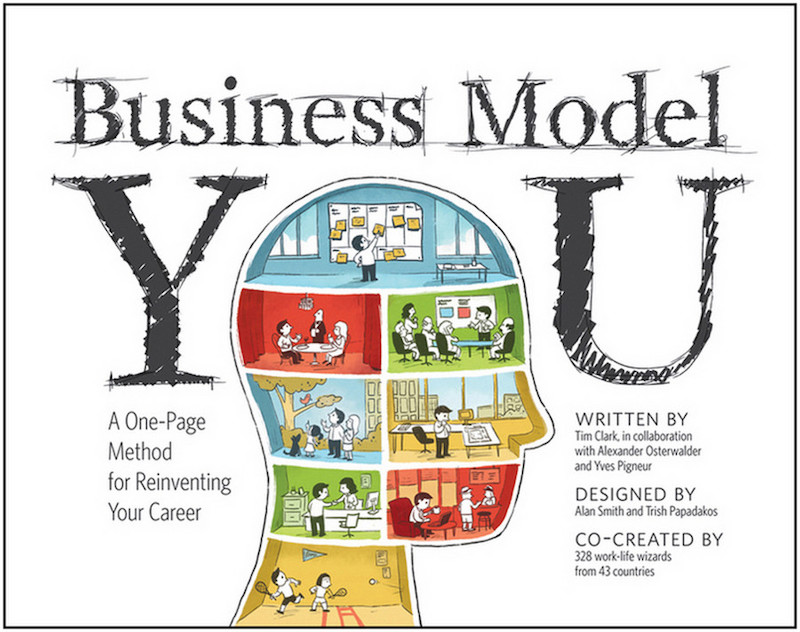Before taking the leap in my own career transition, I looked for resources and tools that could help me identify what I might have forgotten. I wanted to be sure that I had a plan for (or at least the awareness of) as many things as possible before drastically changing my career path and leaving my job.
One of these resources I found to be the most useful was a book called “Business Model You” which talked about a simple but effective method: creating a business model, but for your career transition.

The layout
The layout of this business model is actually quite simple, which is the reason why it’s a great tool. In a moment where you lack clarity and you are full of doubt, you need this kind of tool that will help you put relevant information on paper.
You’ve already seen an example of a personal business model canvas as the featured image of this post, but here’s another look with a bit more information on what each part means.

How to fill in your personal business model canvas
Take a piece of paper (the bigger the better) and use post-its. When I worked on the first draft of my own business model, I did on the floor of my living room before writing it down, so I could use as much space as needed and add as much ideas as I could.
You can also do it in a word document if you prefer an electronic version you can easily edit.
Once you’ve picked the support you are going to use, here’s how you start filling it in.
1) Key resources (who you are and what you have)
Add all your skills, knowledge and abilities. What are your strengths? What are you an expert of? What certification, training, experience you have that will be crucial for your success in your new career?
2) Key activities (what you do)
List all the important tasks and responsibilities you will do in your new job that will make you successful. Focus here on the main activity and the big picture, not the details of your future day-to-day.
3) Customers (who you help)
- External customers: who will you help outside your organisation by doing the activities you have listed in #2? Who will benefit from it directly and indirectly?
- Internal customers: if you want to work for a company, what colleagues will you help through your job? List here your manager, your team, any other part of the organisation you will support directly or indirectly.
4) Value provided (how you help)
What is the value you are going to create for your customers (internal and/or external) (#3) by doing your key activities (#2)? What benefits will people get from your activities?
You can now start seeing how the different parts are linked with each other. At this point in your reflection, it is super important that you have really brainstormed about these first 4 sections.
As you started thinking about the value you want to provide, you might have thought about new activities or new customers – go on and add them now. Be as exhaustive as possible because it will impact the rest of the exercise and the other sections.
5) Channels (how they know you and how you deliver)
How will customers find you? How will you deliver the products and services that they will buy? How will they pay you? List the channels you want to use for your customers to get to know you and start working with you (e.g. website, blog, platform like Etsy or Shopify, Google Adwords, etc.).
6) Customer relationships (how you interact)
How will you talk to your existing customers? Will it be by email, by chat, in person, by video conference?
How will you communicate with your potential clients: with a newsletter, social media, online marketing, etc.?
7) Key partners (who helps you)
Who will help you be successful? Who will support you grow and learn? Who will hep you your main activities, take care of existing customers and find new ones? Think about your professional network but also your personal relationships.
8) Revenue and benefits (what you get)
What activities generate money and how much will your revenue be? What services will you provide or products you will sell, and what’s the pricing? If you start a business and decide to keep a side job, write it down with the salary you get. Do you have any other sources of income?
The idea here is to see how you will make this project financially sustainable.
9) Costs (what you give)
You often need to spend money to make money. List all the subscriptions, professional fees, rent & bills, office supplies, IT equipment, trips, etc. that you will have to spend on to do your job.
Okay, it’s done.
When you think you have finished the first draft, take a break away from it, do something else, and then go back to it to review what you have done. It’s not something you’re supposed to do in one go. It’s a process that can take days, weeks, even months sometimes. Add onto it, talk to people you trust about it (it could be the people you added as key partners (#7)), show them what you have written down and ask for their input.
If you need further help to fill in the canvas, the book “Business Model You” offers a lot of tips and examples. You can easily find it on Amazon.

